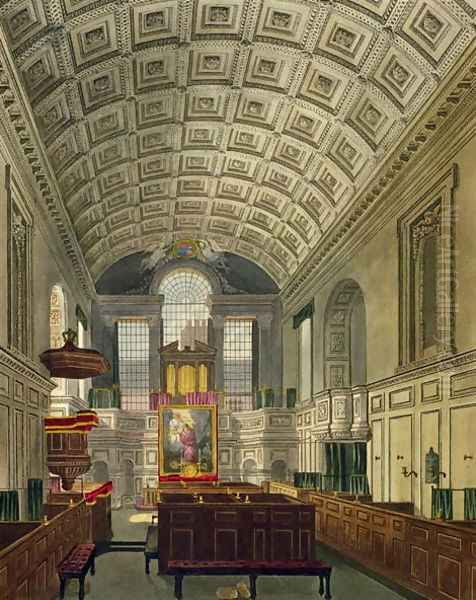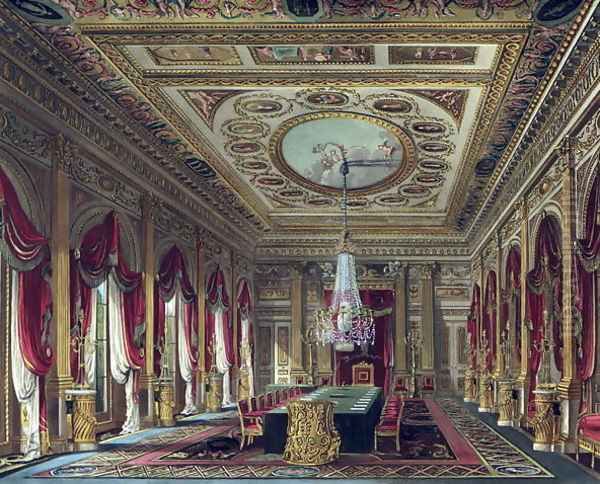Charles Wild (1781-1835) stands as a distinguished figure in the annals of British art, particularly celebrated for his exquisite watercolour depictions of architectural marvels. Working during a vibrant period of artistic innovation and a burgeoning appreciation for the nation's heritage, Wild carved a niche for himself with his meticulous renderings of cathedrals, royal palaces, and grand interiors. His work not only captured the physical likeness of these structures but also conveyed their historical resonance and atmospheric presence, leaving behind a valuable visual record for posterity.
Early Life and Artistic Formation
Born in the bustling metropolis of London in 1781, Charles Wild emerged into an era where the arts were gaining unprecedented public interest. His early artistic inclinations led him to an apprenticeship under Thomas Malton the Younger (1748-1804), a respected topographical draughtsman and teacher of perspective. Malton's studio was a crucible for aspiring architectural artists, and it was here that Wild honed his skills in precise drawing, the understanding of perspective, and the delicate art of watercolour. This training provided a solid foundation for his future specialisation.
Wild's talents soon gained recognition, and he began exhibiting his works at the prestigious Royal Academy of Arts in London. His submissions, often views of significant architectural sites, showcased his developing mastery. An early commission involved creating two views of Christ Church, Oxford, a task he undertook around 1805. This was followed by a series of drawings of Westminster Abbey, a subject that would continue to inspire artists for its historical and architectural significance. In 1808, he further demonstrated his skill with depictions of St. Mary's Church, Oxford, another iconic ecclesiastical structure.
Artistic Style and Preferred Mediums
Charles Wild's artistic signature is characterized by its remarkable detail, accuracy, and a subtle yet effective use of light and shadow to convey volume and atmosphere. He primarily worked in watercolour, a medium that was experiencing a golden age in Britain during his lifetime. Artists were increasingly exploring its versatility, pushing its boundaries beyond mere tinting for drawings into a fully expressive painterly medium.

Wild often enhanced his watercolours with gouache (an opaque watercolour) and bodycolour (watercolour mixed with white to make it opaque) to achieve highlights, richer textures, and greater depth, particularly in rendering intricate architectural ornamentation or the sumptuousness of interior decorations. His palette was generally refined, capable of capturing both the cool stone of ancient cathedrals and the warm glow of decorated staterooms. His meticulous approach ensured that every mullion, tracery, and decorative element was rendered with care, reflecting a deep respect for the structures he depicted. This precision did not, however, result in sterile or purely technical drawings; Wild imbued his scenes with a sense of place and often a quiet dignity.
Subjects of Prominence: Ecclesiastical and Royal Architecture
The primary focus of Charles Wild's oeuvre was architecture, with a particular emphasis on two categories: ecclesiastical buildings and royal residences. His depictions of cathedrals and churches were not merely topographical records but often sought to capture the spiritual aura and historical weight of these sacred spaces. He travelled to document important sites, including the magnificent Amiens Cathedral in France, producing interior views that conveyed its soaring Gothic grandeur. His work on British cathedrals, such as those in Canterbury, York, and Lichfield, contributed to a growing public appreciation for medieval architecture, a sentiment that would fully blossom in the Gothic Revival of the later 19th century.
Equally significant were Wild's portrayals of royal palaces and stately homes. These works offer invaluable insights into the appearance of these residences during the Regency and early Georgian periods. He was commissioned to produce views of interiors at Windsor Castle, Carlton House (the opulent London residence of the Prince Regent, later George IV), and other royal properties. These watercolours meticulously document the lavish decorations, furnishings, and spatial arrangements of rooms that, in some cases, have since been altered or no longer exist. They reflect the prevailing tastes in interior design, from neoclassical elegance to the burgeoning interest in more eclectic and historically inspired styles.
Representative Works and Published Illustrations
Among Charles Wild's most celebrated works are those held within the Royal Collection. A prime example is The Queen's Presence Chamber, Windsor Castle, painted around 1817. This watercolour, executed with pencil, watercolour, and bodycolour, captures the regal atmosphere and detailed ornamentation of this important state room. Another significant piece is The Circular Dining Room, Carlton House, which provides a vivid glimpse into one of the most fashionable and influential interiors of its time.

Wild's talents were also disseminated through published works. He contributed illustrations to William Henry Pyne's The History of the Royal Residences (published 1816-1819), a lavish publication that featured numerous aquatint engravings based on watercolours by Wild and other artists. His hand-coloured engravings, such as The German Chapel, St. James's Palace (1819), and series of coloured aquatints of royal residences, further broadened the reach of his art. These prints allowed a wider audience to appreciate the splendour of Britain's architectural heritage and the skill of artists like Wild who documented it. His series Twelve Select Examples of the Ecclesiastical Architecture of the Middle Ages, chiefly in England also showcased his dedication to medieval structures.
The Society of Painters in Water Colours
Charles Wild was deeply involved in the professional organisation of artists, particularly those working in watercolour. He became a member of the Society of Painters in Water Colours (often referred to as the Old Watercolour Society, founded in 1804) in 1812. This society played a crucial role in elevating the status of watercolour painting, which had often been considered secondary to oil painting. By holding annual exhibitions dedicated solely to watercolours, the society provided a vital platform for artists like Wild to showcase their achievements.
His commitment to the society was evident in his active participation. He served as its secretary from 1822 and later as its president in 1827. His leadership roles underscore the respect he commanded among his peers and his dedication to advancing the cause of watercolour art. The society's membership included many of the leading watercolourists of the day, fostering a collegial environment of mutual support and artistic exchange.
The Artistic Milieu: Contemporaries and Context
Charles Wild operated within a rich and dynamic artistic landscape. The late 18th and early 19th centuries witnessed what is often termed the "Golden Age of English Watercolour." This period saw artists like Thomas Girtin (1775-1802) and J.M.W. Turner (1775-1851) revolutionize the medium. While Girtin's tragically short career laid much of the groundwork for a more expressive and atmospheric use of watercolour, Turner, in his early career, also produced remarkable architectural studies and topographical views before moving towards his more famous sublime landscapes.
Other notable contemporaries who specialized in or frequently depicted architecture and landscapes included:
John Sell Cotman (1782-1842), known for his strong sense of pattern, simplified forms, and distinctive colour harmonies, particularly in his architectural studies and Normandy views.
David Cox (1783-1859), celebrated for his fresh, vigorous handling of watercolour, capturing the effects of weather and light in landscapes and, earlier in his career, architectural subjects. He, like Wild, also taught drawing.
Peter De Wint (1784-1849), admired for his broad, fluid washes and his depictions of the English countryside, often including rustic buildings and agricultural scenes.
Augustus Charles Pugin (1762-1832), a French-born architectural draughtsman who, like Wild, produced meticulous renderings of buildings, particularly Gothic architecture. His son, Augustus Welby Northmore Pugin, became a leading figure of the Gothic Revival.
Samuel Prout (1783-1852), who gained fame for his picturesque depictions of continental European architecture, particularly cathedrals and market scenes, rendered with a characteristic broken line and rich texture.
John Varley (1778-1842), an influential teacher and a prolific watercolourist, known for his classical landscape compositions and his role in the Old Watercolour Society. His brother, Cornelius Varley (1781-1873), was also an accomplished watercolourist and inventor.
William Havell (1782-1857), a founding member of the Old Watercolour Society, known for his landscapes of Britain and his later work in India.
George Fennel Robson (1788-1833), who specialized in mountain scenery and city views, often collaborating with other artists.
Copley Fielding (1787-1855), another prominent member and president of the Old Watercolour Society, famed for his seascapes and landscapes, often with dramatic atmospheric effects.
George Barret Jr. (c.1767-1842), known for his idealized, Claudian landscapes, often suffused with a warm, golden light.
Joshua Cristall (1767-1847), a foundational figure in the Old Watercolour Society, recognized for his classical figure subjects and rustic landscapes.
Francis Nicholson (1753-1844), an older contemporary who was innovative in his watercolour techniques and known for his landscapes and coastal scenes.
This vibrant community of artists, often interconnected through societies like the Old Watercolour Society and shared exhibition spaces, spurred innovation and raised the profile of British art, particularly in the watercolour medium. The public's appetite for topographical views, fueled by travel (both actual and armchair, through prints), Romantic sensibilities, and a growing national consciousness, provided ample opportunities for artists like Wild.
Influence and Lasting Legacy
Charles Wild's primary legacy lies in his meticulous and aesthetically pleasing documentation of early 19th-century architecture. His works serve as invaluable historical records, preserving the appearance of buildings and interiors that have since been altered or lost. For architectural historians and conservationists, his drawings and prints offer crucial visual evidence.
His dedication to depicting Gothic architecture also played a part in the broader cultural shift towards an appreciation of medieval art and design, which was gaining momentum during his lifetime and would culminate in the full-blown Gothic Revival movement. While not a polemicist for a particular style, his careful renderings of cathedrals and ancient churches undoubtedly fostered interest in these structures.
Furthermore, his active role in the Old Watercolour Society contributed to the professionalization and elevation of watercolour painting as a serious art form. He, along with his contemporaries, demonstrated the medium's capacity for detailed representation, atmospheric effect, and artistic expression, paving the way for future generations of watercolourists.
Charles Wild passed away in 1835, leaving behind a significant body of work that continues to be admired for its technical skill, historical value, and quiet beauty. His watercolours are held in major collections, including the Royal Collection, the Victoria and Albert Museum, and the British Museum, testament to his enduring importance as a chronicler of Britain's architectural heritage and a master of the watercolour medium. His art provides a window into the past, allowing us to see these magnificent structures through the eyes of a skilled and sensitive observer.